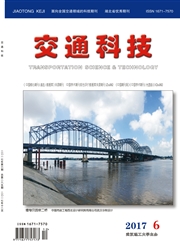

 中文摘要:
中文摘要:
针对我国城市干路接入口管理现状,分别从宏观、中观及微观层面,研究适合我国国情的接入口管理技术策略,并进行实用性对比分析。在此基础上,为综合评价干路接入口管理效果,确立了延误的评价指标,并针对城市干路接入口混合流中的非机动车和行人,提出了“非直线延误”的新概念及计算模型。
 英文摘要:
英文摘要:
In allusion to the actual access management of the urban arterial roads in our country, it carries out the study from the macro-level, medium-level and micro-level to explore the corresponding technologies fitting our arterial roads, and then analyzes the relation between the technologies and their utilities. Moreover, for the comprehensive evaluation of the improvement, it establishes the delay as the index firstly. Then aiming at the pedestrians and bicyclists in the mixed flow, it advances a new definition of the nonlinear delay and the computational models according to the characteristics of the access roads and arterial roads respectively which improve the integrative evaluating system. The computational models will put forward gist for the choice of the access location, the establishment of the management and control, then the design for the infrastructures as well. Besides, it will also be useful to improve the evaluation of the run of the accesses. Simultaneously, it will be help for boosting the level of the access management and the current operation and efficiency of arterial roads in our country.
 同期刊论文项目
同期刊论文项目
 同项目期刊论文
同项目期刊论文
 期刊信息
期刊信息
